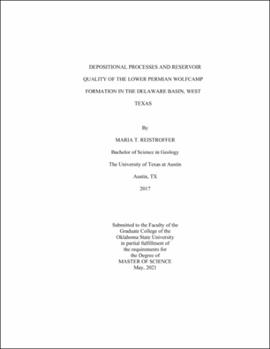| dc.contributor.advisor | Grammer, Michael | |
| dc.contributor.author | Reistroffer, Maria Therese | |
| dc.date.accessioned | 2023-03-27T20:51:04Z | |
| dc.date.available | 2023-03-27T20:51:04Z | |
| dc.date.issued | 2021-05 | |
| dc.identifier.uri | https://hdl.handle.net/11244/337167 | |
| dc.description.abstract | The Delaware Basin, located in southeast New Mexico and west Texas, is the westernmost sub-basin of the Permian Basin. With an estimated 24 billion barrels of recoverable oil, the lower Permian Wolfcamp Formation is one of the most productive unconventional petroleum systems in the U.S. and is characterized by significant lateral and vertical heterogeneity in a mixed carbonate-siliciclastic system. Understanding the depositional processes and petrophysical parameters associated with the reservoir facies in the lower Permian Wolfcamp Formation has major implications for maximizing hydrocarbon production. | |
| dc.description.abstract | Upper Wolfcamp A lithologies in the Delaware Basin vary from calcareous and siliciclastic organic–rich mudstones, siltstones, wackestones, and grain dominated packstones. These Leonardian-aged slope to basin deposits were primarily sourced from the adjacent carbonate-dominated Central Basin Platform and the siliciclastic-dominated Northwest Shelf. As a result, upper Wolfcamp sedimentation is dominated by a mix of carbonate and siliciclastic sediment gravity flow deposits. These deposits are driven by high amplitude global sea level fluctuations associated with the growth and ablation of continental ice during Permian icehouse conditions. During these periods of eustatic fluctuation, increased siliciclastic bypass and deposition into the Basin occurred during low-stands of sea level. Carbonate materials dominated transgressive and highstand sedimentation, with carbonate detritus being shed off the adjacent Central Basin Platform. | |
| dc.description.abstract | This study evaluates the reservoir quality of two Wolfcamp A cores in the west Texas area of the Delaware Basin and how reservoir quality in these cores varies on a sub-meter scale as a result of depositional processes and diagenesis. The integration of datasets including cores, thin sections, wireline logs, and laboratory measured petrophysical properties, illustrates that the Wolfcamp A is heterogeneous in composition and characterized by low porosity and varying permeability. The pore system architecture is analyzed using ion milled environmental scanning electron microscopy (ESEM) and digital image analysis of micro- to nanometer scale pores. Siliceous and argillaceous mudstones to siltstones show simpler pore structures and overall larger pores that contribute to higher permeability in measured core samples. In contrast, carbonate mudstones to packstones have complex pore structures and smaller pores that contribute less to permeability in samples measured from core. | |
| dc.format | application/pdf | |
| dc.language | en_US | |
| dc.rights | Copyright is held by the author who has granted the Oklahoma State University Library the non-exclusive right to share this material in its institutional repository. Contact Digital Library Services at lib-dls@okstate.edu or 405-744-9161 for the permission policy on the use, reproduction or distribution of this material. | |
| dc.title | Depositional processes and reservoir quality of the lower Permian Wolfcamp Formation in the Delaware Basin, West Texas | |
| dc.contributor.committeeMember | Puckette, James | |
| dc.contributor.committeeMember | Gregg, Jay | |
| osu.filename | Reistroffer_okstate_0664M_17201.pdf | |
| osu.accesstype | Open Access | |
| dc.type.genre | Thesis | |
| dc.type.material | Text | |
| dc.subject.keywords | Delaware Basin | |
| dc.subject.keywords | gravity flows | |
| dc.subject.keywords | pore systems | |
| dc.subject.keywords | reservoir | |
| dc.subject.keywords | turbidites | |
| dc.subject.keywords | Wolfcamp | |
| thesis.degree.discipline | Geology | |
| thesis.degree.grantor | Oklahoma State University | |


